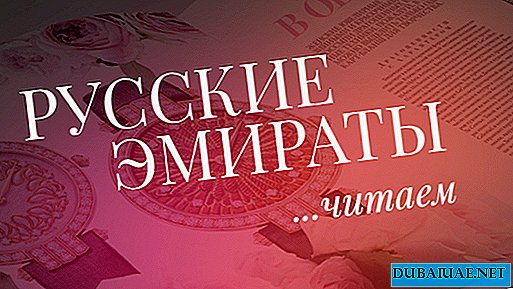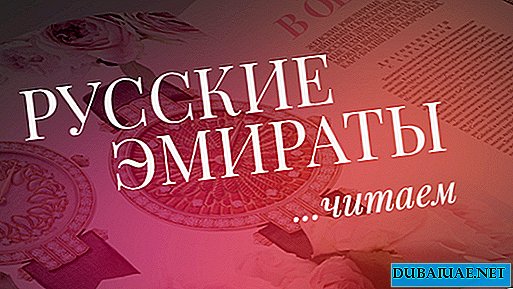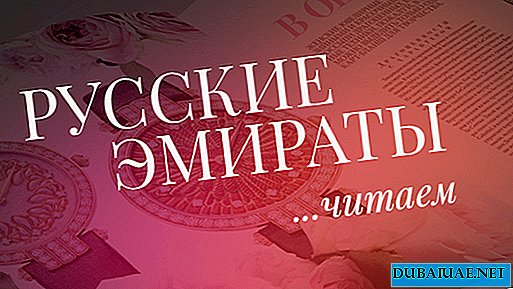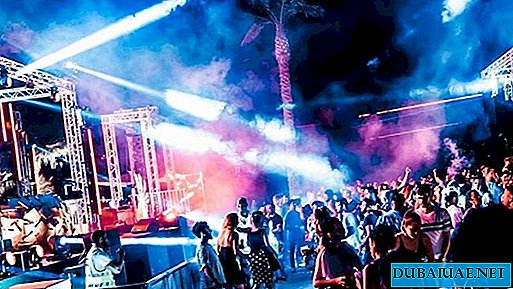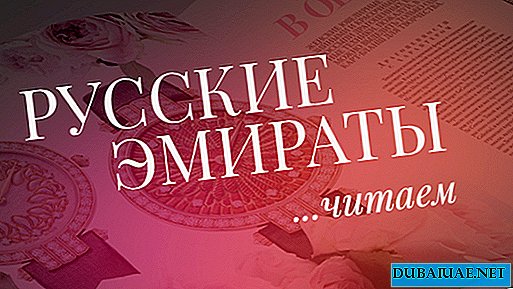 Muhammad Mandi in the Emirates is known to everyone who lives in or visits the country. True, for the vast majority of residents and guests, acquaintance with this person is limited to what he does. Anyone who has spent at least a couple of hours under the local warm sky comes across his work several times a day. Readers of our magazine will now know Muhammad Mandi in person and in life. Acquaintance is very pleasant, because he is an interesting, enthusiastic and kind person. The acquaintance is worthwhile because when you open your wallet, you will see the fruits of his labors, which paid for your labors, and you pay for others.
Muhammad Mandi in the Emirates is known to everyone who lives in or visits the country. True, for the vast majority of residents and guests, acquaintance with this person is limited to what he does. Anyone who has spent at least a couple of hours under the local warm sky comes across his work several times a day. Readers of our magazine will now know Muhammad Mandi in person and in life. Acquaintance is very pleasant, because he is an interesting, enthusiastic and kind person. The acquaintance is worthwhile because when you open your wallet, you will see the fruits of his labors, which paid for your labors, and you pay for others.
Muhammad draws money. All emirate banknotes, starting with the red five decorated with a minaret and a falcon, dozens with a palm tree weighed down by beautiful clusters of dates, the same falcon and a curved “jambia” in scabbard, and ending with the Abu Dhabi skyscraper “Burj Bainun” on a denomination of 1000 dirhams , came out from under his kalyama. All beautiful Arabic inscriptions on paper banknotes are made by him. Many commemorative metal coins distributed in collections of numismatists around the world, logos of official institutions, major political and sports events are also the result of the work of Muhammad Mandi.
Muhammad is the best emirate calligrapher artist. Deputy Director of the Organization of Culture and Art of the Capital Cultural Foundation has created not only the national currency. Bahraini and Kuwaiti dinars are the work of his skillful hands and talented imagination. He fantasized over the appearance of the most expensive notes of the current Syrian currency. He issued travel passports of the indigenous people of all the Arab countries of the Persian Gulf, except for Saudi Arabia.
“My atmosphere is colors and paints, aromas and smokes,” the 50-year-old artist told me. His workshop in the Cultural Fund of the Emirate's capital is indeed bright and fragrant. On the desktop to the right of it, incense flows from a small censer. We are covered in arabesques with blue smoke. Blue and violet colors for the emirate calligrapher symbolize peace and beauty. He treats red, black and orange with concern. Pink considers "moderate and good mood."
On the walls of the picture. Shelves and a table are littered with a pile of sketches, sketches, magazines, among which he quickly and easily finds what he needs. Like any enthusiastic man in love with his job, he is simple, open and devoid of any kind of art. Next to him, I feel as if I have known him all my life.
Muhammad draws not only money, passports and logos. He is the author of portraits, paintings and arabesques. His work includes traditional calligraphy, arabesques, written in his own only manner, but within the framework of rules and norms that have evolved over centuries. He creates artistic images from sets of picturesque Arabic letters and draws portraits of famous people, composing his works from the proper names of prototypes.
Captured by the art of writing letters, the calligrapher studied in Egypt and Turkey. He worships his teachers, draws them, treats them like icons, he himself teaches fiction and continues to study. He will spend this summer in Turkey to receive recognition and a diploma from masters, whose art he admires to such an extent that, telling me about them, he puts his lips to their photographs. Muhammad regrets that the Arabs did not maintain a high level of calligraphy, which was at the peak of perfection in the Middle Ages. Turks continue to lead in this peculiar sphere of art based on Arabic script, having long since seized the palm of Arabs in calligraphy from the Arabs. They are followed by the Iranians.
 And at the same time, the Arab may not be literate enough, but by tradition he is called upon to write beautifully. Arabs did not enjoy any kind of creativity more attention than calligraphy, which had a huge impact on the visual arts, architecture and crafts, which struck the Western world with its beauty. This art is all the more surprising because the lifestyle of the Arabian inhabitants did not contribute to the development of their writing. Its take-off began after the caliph Osman ibn Affan ordered the divine revelations to be written to the Prophet Muhammad in one holy book, called the Koran. The divine purpose of writing required a great deal of diligence. The scribes tried. Handwriting multiplied. The desire for beauty with the rejection of Islam images of people and animals prompted a special decoration of the texts. Cramped by the framework of religious prohibitions, artistic genius found a way out in the skilful writing of letters, words and lines. So arabesques appeared.
And at the same time, the Arab may not be literate enough, but by tradition he is called upon to write beautifully. Arabs did not enjoy any kind of creativity more attention than calligraphy, which had a huge impact on the visual arts, architecture and crafts, which struck the Western world with its beauty. This art is all the more surprising because the lifestyle of the Arabian inhabitants did not contribute to the development of their writing. Its take-off began after the caliph Osman ibn Affan ordered the divine revelations to be written to the Prophet Muhammad in one holy book, called the Koran. The divine purpose of writing required a great deal of diligence. The scribes tried. Handwriting multiplied. The desire for beauty with the rejection of Islam images of people and animals prompted a special decoration of the texts. Cramped by the framework of religious prohibitions, artistic genius found a way out in the skilful writing of letters, words and lines. So arabesques appeared.
Beautiful handwriting has come to be seen as evidence of virtue and true faith. Religious authorities regarded the art of calligrapher as a holy blessed work. Handwriting was called "the language of the soul," "one of the foundations of eloquence." The famous Arab medieval thinker al-Farabi said that "the spirit, expressed by the senses of the body, is at the heart of the handwriting."
In the process of improving calligraphy, the authority of scribes has grown. The Caliphs took care of the talents who best possessed the reed kalam - a tool of writing. Only poets were more respected than scribes in the Arab Middle Ages, but they also sought to bring the most talented masters of Kalam to themselves in order to enhance sound harmonies with the magic of refined images. The best calligraphers lived at the palaces. She was friends with nobility. In mosques, imams praised them. The bazaars of Mecca and Medina, Damascus, Baghdad and Basra repeated their names. One of the gifted scribes was said to have depicted the phrase “In the name of Allah the Merciful the Merciful” so often used by Muslims that he deserved the forgiveness of all sins. The spellings of this phrase are innumerable, as are the multiple, elaborate images of the words "Muhammad" and "Allah." The Arabic masters of writing compare the charm of the letters of this last word with the simplicity of opening the Arabic alphabet and consisting of one elegant dash, vertical, with a slight bend of the letter "alif". In spelling the word, they see the harmony of cypress and the sublime pride of the minaret. Each master tries to find his own versions of the image of alphabetic characters, raising them above the line and the text, forcing them to soar or laying on the line with the foundation of the written structure.
 A petition put on paper with artistic delights, with the caliphs, could be a guarantee of success in resolving a lawsuit, satisfying a complaint, and sometimes save a life. The negligence of the letter threatened trouble. One of the Arab rulers, for example, returned to the intercessor his writings with the following sentence: “A beautiful line could clarify the arguments, make the goals achievable and become an intercessor to you. If you really repented, your hand would help you. We would like to accept your apologies, but changed your mind because of the vulgarity of your handwriting. "
A petition put on paper with artistic delights, with the caliphs, could be a guarantee of success in resolving a lawsuit, satisfying a complaint, and sometimes save a life. The negligence of the letter threatened trouble. One of the Arab rulers, for example, returned to the intercessor his writings with the following sentence: “A beautiful line could clarify the arguments, make the goals achievable and become an intercessor to you. If you really repented, your hand would help you. We would like to accept your apologies, but changed your mind because of the vulgarity of your handwriting. "
Miracle writing was perfected in Turkey and Persia, who gave their great artists who created new, amazingly beautiful handwritings. About 20 Turkish sultans were outstanding calligraphers. Their names and aphorisms were written in a special handwriting "Tugra". Firmans of the Sultans registered the majestic "divan". In the financial sector, they used the "sixt". Everyday clerical affairs were carried out in Rika's handwriting. Turkish writing was translated into Latin in 1928. However, the people maintain the traditions of calligraphy and still continue to create calligraphic masterpieces. In Saudi schools, the manner of writing is taught as a separate discipline, which once existed in our country in the form of calligraphy. Many Arab countries have special calligrapher schools.
Recently, lettering images of animals, birds, household utensils have become popular among Muslim artists. Using the wavy lines of letters, scribes like to depict ships, trees, objects of everyday life. Arab calligraphers paid tribute to the era of the confrontation of a market economy and a communist idea that has not yet ended in favor of Marxism. The author of these lines saw on the walls of houses in Arab cities and on the sides of cars an image of the name "Muhammad" in the form of one of the Soviet symbols - a five-pointed star. Like all art, arabesques lived and live the spirit of the times!
See how your Arab acquaintances sign. The signatures of many of them are works of art, arabesques. Arabic letters are distinguished by amazing decorativeness. This difference between them served the appearance of many handwritings, among which six are considered the main ones. These include "nash", which became the basis of the printed Arabic script, horizontally stretched "muhakkak", refined "taukia" and their variants - "suls" and "Reihani", as well as "rika", which is now the main italic style. The strict and monumental handwriting of “kufi”, named after the Iraqi city of Kufa, still retains its significance. Standing out with straight lines, clear verticals, corners and strict horizontal lines, he now is an example of solemn writing. You see it on the emirate banknotes of Muhammad Mandi.
Muhammad began his creative activity with Kufic writing. The main textbook was the Qur'an, which first corresponded with the handwriting "kufi". Then the artist became interested in “sofas”, “sulse”, “naskh”, “rika”. Some of them are used for painting mosques, others - for street signs, others - for letters from the rulers, and "naskh" - for the Koran.
 For a whole year he worked on a portrait of the late UAE President Sheikh Zayed bin Sultan Al-Nahyan without any order, driven by his own desire and respect for the national leader. A picturesque portrait combined with calligraphic inscriptions named after the father of the nation. A similar portrait is dedicated to the French president Jacques Chirac, made for one and Parisian exhibitions and received very high praise in the country of artists and fashion designers.
For a whole year he worked on a portrait of the late UAE President Sheikh Zayed bin Sultan Al-Nahyan without any order, driven by his own desire and respect for the national leader. A picturesque portrait combined with calligraphic inscriptions named after the father of the nation. A similar portrait is dedicated to the French president Jacques Chirac, made for one and Parisian exhibitions and received very high praise in the country of artists and fashion designers.
Arabic writing, developed and improved thanks to numerous generations of believers in dozens of countries over the course of a millennium (the first Quran was printed only in 1538, almost 100 years after the invention of the printing press), in the process of writing phrases and words inspired by faith by true believers, remains divine by letter. The patterns of arabesques contain no less mystery than in the concepts and meanings they depict. Reading many of them requires great effort, like comprehending the truth of God. Arabesques can be called "divine crosswords," which not only strain the mind, but also delight the eye. Finding the key to the beauty of the lines is immeasurable.
Muhammad Mandi paid and pays tribute to the sacred sacrament. He has his own options for writing traditional sacred, ritual phrases. Once, during a small Hajj (Omra) to Mecca, being on the top floor of the main Meccan mosque and looking at the hajjs that made the roundabout of the Kaaba, he was inspired by the idea of depicting the oldest sacred building in the center of the mosque surrounded by “slaves of Allah” in the form of their names, compiled from using 99 magnificent epithets of the Most High, All-Seeing, Merciful, the Merciful, etc. So the picture of the Kaaba appeared in the form of the words "This is Allah. There is no Deity but him." Around her are endless rows of slaves of the Loving, Giver, Almighty, Almighty, All-Good, Lord, All-Forgiving, Glorious and so on.
Muhammad Mandi is 50 years old. He has done a lot, gained recognition in his country and abroad, has many awards and titles, but continues to study and travels to Turkey for this. He dreams of rewriting the Qur'an in a beautiful artistic style. Rewrite. Patience and hard work does not occupy him.
Victor Lebedev


